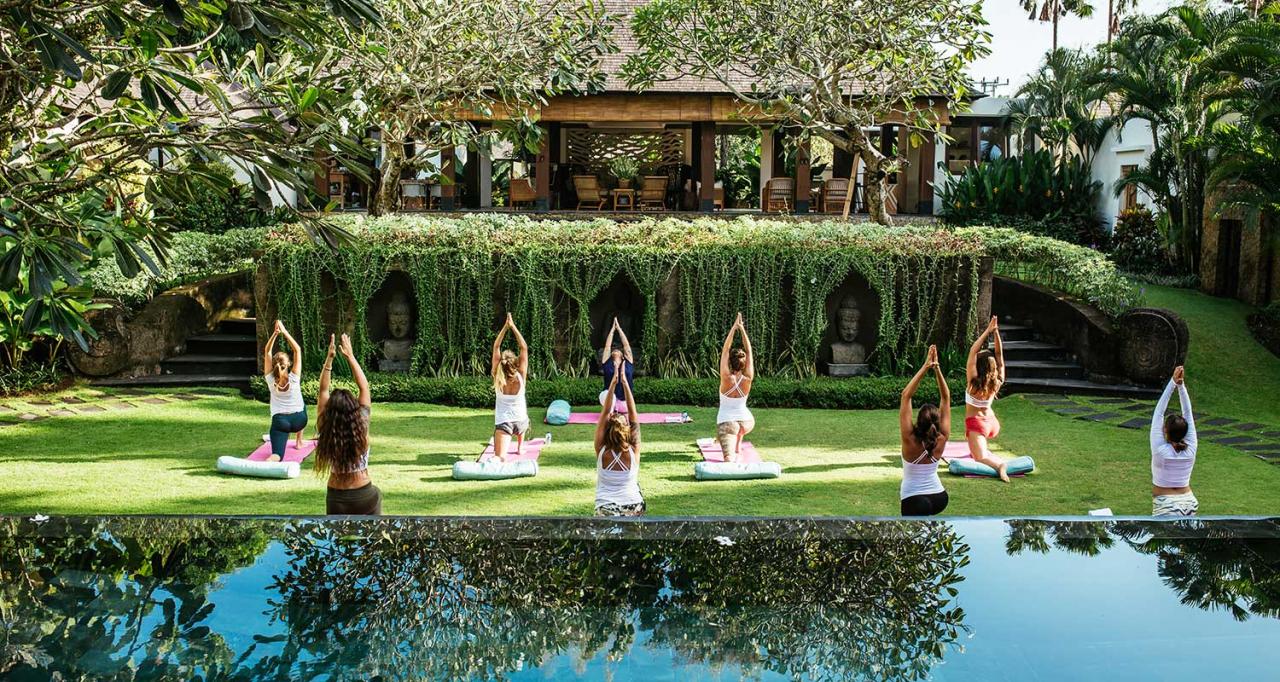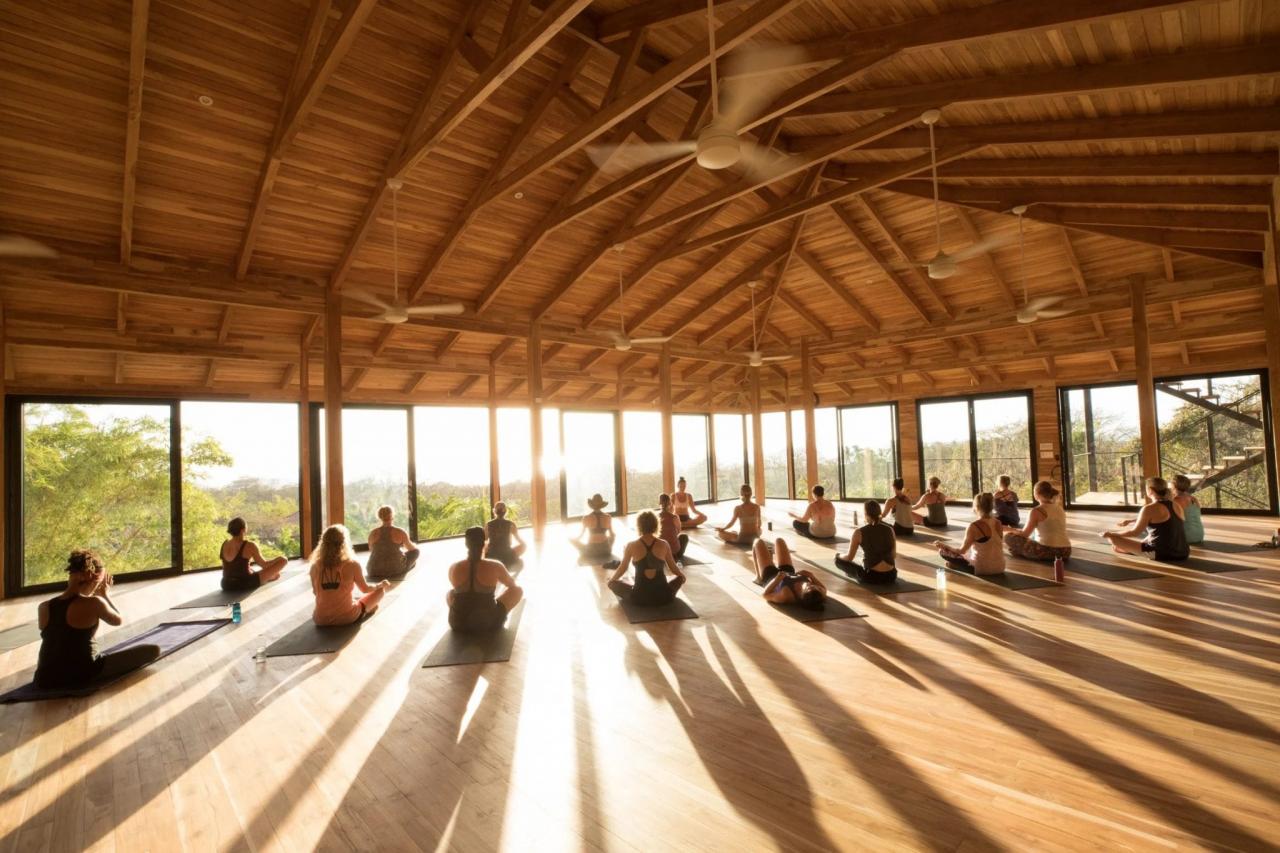
Curriculum and Activities

A well-structured yoga retreat curriculum is crucial for providing participants with a transformative and memorable experience. It should offer a balance of physical practice, mental exploration, and opportunities for relaxation and rejuvenation. A carefully planned schedule ensures participants feel supported and engaged throughout their retreat journey.A diverse range of activities beyond traditional yoga asana practice is essential for creating a holistic and engaging retreat experience.
Incorporating activities like hiking, workshops, or spa treatments caters to different interests and provides opportunities for personal growth and connection with nature. This variety prevents monotony and allows participants to explore various avenues for self-discovery and well-being.
Sample Daily Schedule
A typical day at our yoga retreat might unfold as follows:
- :00 AM: Wake up, herbal tea & mindful breathing
- :30 AM: Sunrise Vinyasa Flow Yoga (60 minutes)
- :30 AM: Nourishing Breakfast
- :30 AM: Optional: Guided Meditation or Hiking excursion
- :00 AM: Free time for journaling, relaxation, or exploring the retreat grounds.
- :00 PM: Lunch
- :00 PM: Workshop: Introduction to Ayurveda or Yoga Philosophy
- :00 PM: Restorative Yoga & Yoga Nidra (60 minutes)
- :00 PM: Free time/Spa Treatments
- :00 PM: Dinner
- :00 PM: Evening Kirtan or Sound Healing
Importance of Diverse Activities
Beyond the core yoga practice, a variety of activities enhance the overall retreat experience. Hiking, for instance, connects participants with nature, fostering a sense of peace and grounding. Workshops on topics such as Ayurveda or mindful eating offer opportunities for learning and personal growth, while spa treatments provide deep relaxation and rejuvenation. This diversification caters to individual preferences and promotes a well-rounded experience, leaving participants feeling refreshed, revitalized, and inspired.
Creating a Balanced and Engaging Retreat Program
A successful yoga retreat program strikes a balance between structured activities and free time. The schedule should include a mix of vigorous and restorative yoga practices, contemplative sessions, and opportunities for social interaction and personal reflection. The integration of workshops and other activities adds depth and variety, ensuring that participants’ diverse needs and interests are addressed. Careful consideration of pacing and mindful scheduling prevents overstimulation, allowing for genuine relaxation and rejuvenation.
Potential Retreat Activities
A thoughtfully curated selection of activities enhances the overall retreat experience. Here are ten examples:
- Sunrise Yoga & Meditation
- Vinyasa Flow Yoga
- Restorative Yoga & Yoga Nidra
- Guided Meditation Sessions
- Hiking or Nature Walks
- Ayurveda Workshop
- Yoga Philosophy Workshop
- Sound Healing Session
- Spa Treatments (Massage, etc.)
- Cooking Class focusing on healthy, plant-based cuisine
Illustrative Examples

To further illustrate the diverse range of yoga retreat experiences, we present three distinct examples showcasing the variety in location, budget, and focus. These examples highlight the potential for a transformative journey, regardless of individual preferences or financial constraints.
A Luxurious Balinese Yoga Retreat
Imagine waking to the sounds of Balinese gamelan music drifting on the gentle ocean breeze, the scent of frangipani and plumeria filling the air. This luxury retreat is nestled amidst lush rice paddies and overlooking the turquoise waters of the Indian Ocean. The villas are exquisitely designed, featuring private plunge pools, outdoor showers, and handcrafted furnishings. Days are filled with invigorating Vinyasa flow classes on open-air decks, overlooking the ocean.
Evenings offer restorative Yin yoga sessions under a canopy of stars, accompanied by the soothing sounds of the waves. Between yoga sessions, guests can indulge in rejuvenating spa treatments using locally sourced ingredients, explore ancient temples, or simply relax by the infinity pool, sipping fresh coconut water. The food is a culinary delight, featuring fresh, organic ingredients prepared by talented chefs, focusing on healthy and flavorful Balinese cuisine.
The overall experience is one of unparalleled serenity and rejuvenation, a true escape from the everyday.
A Budget-Friendly Rural Yoga Retreat
This retreat offers a different kind of escape, emphasizing simplicity and connection with nature. Located in a quiet rural setting, perhaps a secluded valley or a farm, this retreat prioritizes affordability and community. Accommodation might be in rustic cabins or shared dorm-style rooms, emphasizing a sense of shared experience. Yoga classes are held in a simple but comfortable space, possibly an open-air barn or a renovated farmhouse.
The focus is on foundational practices, fostering a strong sense of community amongst participants. Days are filled with mindful movement, meditation, and opportunities for connecting with the natural world through hiking, foraging, or simply relaxing by a campfire under the starry sky. Meals are simple, wholesome, and often sourced locally, creating a sense of shared nourishment. The atmosphere is intimate and supportive, fostering deep personal connections between participants and instructors.
The experience is about finding peace and grounding oneself in the simplicity of nature and the strength of community.
An Ashtanga Yoga Retreat
This retreat centers around the rigorous and dynamic practice of Ashtanga yoga. The days begin early, with a challenging Mysore-style practice, allowing each participant to progress at their own pace, guided by an experienced Ashtanga teacher. The teacher provides personalized adjustments and modifications, ensuring the safety and effectiveness of each student’s practice. The Ashtanga sequence, a carefully structured series of postures, is the core of the retreat.
The emphasis is on building strength, stamina, and flexibility through consistent practice. The retreat might incorporate workshops focusing on specific aspects of the Ashtanga method, such as vinyasas, drishtis (gaze points), and ujjayi breath. In addition to the primary series, participants might explore intermediate or advanced series depending on their experience level. The atmosphere is focused and dedicated, providing an opportunity for serious students to deepen their Ashtanga practice in a supportive and challenging environment.
Beyond the asana practice, the retreat may incorporate pranayama (breathing techniques) and meditation to enhance the overall experience. The detailed sequencing, precise alignment, and mindful breathing are emphasized throughout the retreat.